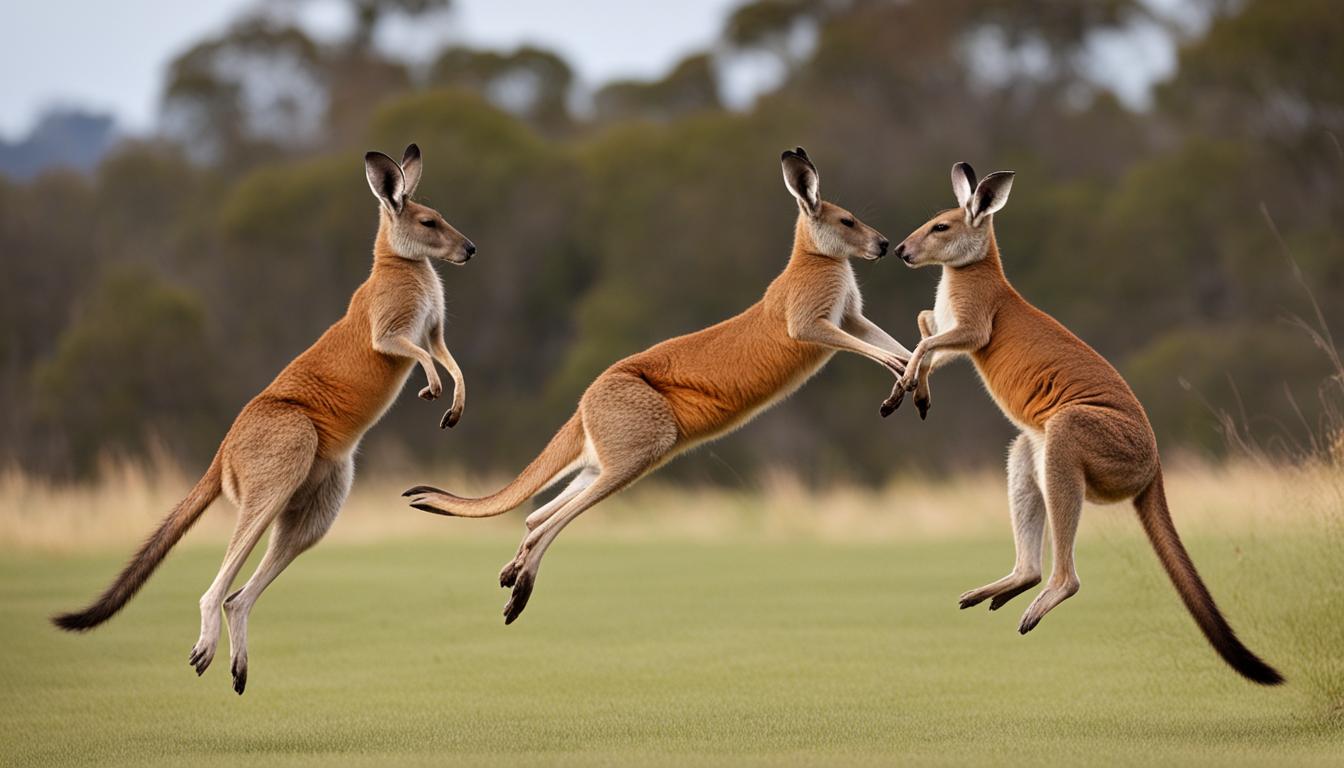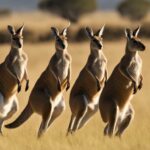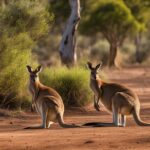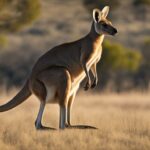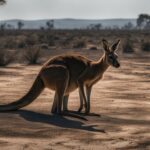Kangaroos, iconic marsupials of Australia, are often misunderstood creatures. Despite their reputation as pests among farmers, they possess many intriguing qualities. From their unique biology to their social behavior, here are some lesser-known facts about kangaroos.
Did you know that kangaroos are the largest living marsupials? They come in various species, including the red kangaroo, eastern gray kangaroo, and western gray kangaroo. But what truly sets them apart is their incredible adaptation – their large hind legs that enable them to hop at high speeds and cover long distances efficiently. It’s like nature’s built-in superpower!
Kangaroos are also social animals. They live in groups called mobs or troops, led by dominant males known as bucks. Communication among kangaroos is fascinating – they use body language, including various movements and tail wagging, to express themselves. They even have a unique handedness, with a preference for their left hand for precision tasks and their right hand for strength-related tasks.
When it comes to reproduction, female kangaroos have a pouch on their belly where they carry their young, called joeys. These joeys are born extremely undeveloped and must crawl into the pouch to continue growing and developing. And here’s something incredible – female kangaroos can delay the development of their embryos until conditions are favorable. Talk about the wonders of nature!
Kangaroos are herbivores, primarily feeding on grass, leaves, and other vegetation. They have specialized teeth for grinding down plant material. And did you know that they can regurgitate their food and chew it as cud, similar to ruminant animals? However, this behavior is not necessary for digestion and only occurs occasionally.
These fascinating creatures are well-adapted to the arid Australian outback. They can conserve water and reduce their metabolic rate during dry spells. Moreover, kangaroos play a vital role in Australian ecosystems by controlling vegetation and maintaining balance in their habitats.
Kangaroos are truly unique and captivating animals. Their jumping abilities, reproductive system, social behavior, adaptability, and ecological roles make them a true wonder of the animal kingdom. So next time you encounter a kangaroo, take a moment to appreciate the remarkable qualities of these iconic marsupials. They are simply awe-inspiring!
Kangaroo Biology and Adaptations
Kangaroos are fascinating creatures with unique biology and remarkable adaptations. As the largest living marsupials, kangaroos come in various species, including the red kangaroo, eastern gray kangaroo, and western gray kangaroo. These species showcase different sizes and characteristics, but they all share a common adaptation that sets them apart from other animals – their large hind legs.
These powerful hind legs enable kangaroos to hop at high speeds and cover long distances efficiently. The anatomy and musculature of their legs are specifically designed for this purpose. Additionally, kangaroos have a muscular tail that acts as a fifth leg when moving at slower speeds, providing balance and stability.
These adaptations make kangaroos incredibly well-suited to their environment and way of life. They can navigate vast open spaces and rugged terrains with ease, making them agile and formidable creatures in their natural habitat.
Table: Comparison of Kangaroo Species
| Kangaroo Species | Size | Characteristics |
|---|---|---|
| Red Kangaroo | Largest species | Powerful hind legs for hopping and bounding |
| Eastern Gray Kangaroo | Smaller than the red kangaroo | Adaptable to various habitats |
| Western Gray Kangaroo | Similar size to the eastern gray kangaroo | Found in the southwestern parts of Australia |
Kangaroo Behavior and Social Structure
Kangaroos are fascinating creatures not only for their unique biology but also for their intriguing behavior and social structure. These marsupials exhibit complex social dynamics and communicate through various forms of body language.
In their social groups, known as mobs or troops, kangaroos establish hierarchies led by dominant males called bucks. These bucks play a crucial role in protecting and leading the group, ensuring the safety and well-being of their members. Through dominant displays and physical battles, bucks assert their authority, maintaining order within the troop.
Kangaroos rely heavily on body language to communicate with one another. They use various movements, such as boxing, kicking, and tail wagging, to express dominance, submission, or aggression. These non-verbal cues help them establish and maintain social relationships within the troop.
Kangaroo Handedness
One fascinating aspect of kangaroo behavior is their handedness. Just like humans, kangaroos have a preference for using one hand over the other for specific tasks. They show a preference for their left hand when it comes to precision tasks, such as grooming or manipulating objects, and their right hand for strength-related tasks, such as digging or defending themselves.
This unequal distribution of hand usage, known as handedness or manual lateralization, is thought to be influenced by brain asymmetry. It allows kangaroos to optimize their motor skills and adapt to the demands of their environment.
| Left Hand | Right Hand |
|---|---|
| Precision tasks (grooming, manipulating objects) | Strength-related tasks (digging, defending) |
Overall, the behavior and social structure of kangaroos provide a glimpse into the intricate dynamics of these captivating marsupials. From dominant displays to non-verbal communication and handedness, these aspects contribute to the complex social lives and survival strategies of kangaroo troops.
Kangaroo Reproduction and Parenting
Kangaroo reproduction is a fascinating process that showcases the unique biology of these iconic marsupials. Female kangaroos have a distinctive feature – a pouch on their belly where they carry their young, known as joeys. The pouch provides a safe and nurturing environment for the developing joey.
When a female kangaroo mates, she becomes pregnant and gives birth to a tiny, undeveloped joey. At birth, the joey is blind, hairless, and only about the size of a jellybean. It instinctively crawls its way into the mother’s pouch, where it latches onto a teat and continues to grow and develop.
One remarkable aspect of kangaroo reproduction is the phenomenon of embryonic diapause. This means that female kangaroos can delay the development of their embryos until conditions are favorable, such as when there is ample food and water available. This adaptation allows them to ensure the survival of their offspring even in challenging environments.

“The kangaroo’s pouch is an incredible adaptation that ensures the survival of their young, providing a nurturing environment for their development.”
Kangaroo Diet and Eating Habits
Kangaroos have a unique diet that consists mainly of grass, leaves, and other vegetation. As herbivores, they rely on plant material for their sustenance and have specialized adaptations to aid in their consumption of these fibrous foods. With their muscular jaws and specialized teeth, kangaroos are equipped to grind down tough plant matter for digestion.
One interesting eating habit of kangaroos is their ability to regurgitate their food and chew it as cud, similar to ruminant animals. However, this behavior is not a necessary part of their digestion process and is only observed occasionally. Kangaroos primarily chew their food thoroughly before swallowing, but on occasion, they may bring back partially digested food to further break it down.
It’s important to note that kangaroos’ diet may vary slightly depending on their species and the availability of food in their habitat. For example, some species of kangaroos may have a broader diet that includes fruits and seeds in addition to grass and leaves.
| Kangaroo Diet | Primary Food Sources |
|---|---|
| Grass | Majority of their diet |
| Leaves | Key source of nutrients |
| Other Vegetation | Depending on species and habitat |
Overall, the kangaroo’s diet showcases their adaptability as herbivores and their ability to thrive on a primarily plant-based diet. Their unique eating habits and specialized teeth enhance their efficiency in extracting nutrients from fibrous vegetation, enabling them to survive and flourish in their natural habitats.
Kangaroo Habitat and Adaptations to Arid Environments
Kangaroos are well-adapted to the arid Australian outback, where they inhabit a variety of habitats, including open grasslands, deserts, and scrubs. These environments pose unique challenges, such as limited water resources and extreme temperatures, but kangaroos have evolved remarkable adaptations that allow them to thrive in such conditions.
One of the key adaptations of kangaroos is their ability to conserve water. Unlike humans and many other mammals, kangaroos do not sweat to cool themselves down. Instead, they rely on their efficient water-conserving mechanism. Kangaroos have developed the ability to produce concentrated urine, minimizing water loss. Additionally, their digestive system is remarkably efficient, enabling them to extract as much moisture as possible from their fibrous, low-water-content diet.
Another crucial adaptation of kangaroos is their ability to reduce their metabolic rate during dry spells. When water and food are scarce, kangaroos enter a state of torpor, lowering their energy expenditure and conserving resources. This metabolic slowdown allows them to survive for extended periods without access to sufficient food and water. Kangaroos are truly masters of adaptation, with their physiology and behavior finely tuned to the challenges of living in arid environments.
Furthermore, the unique body structure of kangaroos plays a vital role in their adaptation to arid habitats. Their large, powerful hind legs and muscular tail allow them to cover long distances efficiently while expending minimal energy. This adaptation is especially advantageous in arid regions where resources are spread out, allowing kangaroos to travel to different feeding areas with ease. Their ability to hop enables them to conserve energy and move quickly across vast expanses of arid landscape.
Table: Adaptations of Kangaroos to Arid Environments
| Adaptation | Description |
|---|---|
| Water Conservation Mechanism | Kangaroos produce concentrated urine and efficiently extract moisture from their diet, minimizing water loss. |
| Metabolic Slowdown | During dry spells, kangaroos reduce their metabolic rate, conserving energy and resources. |
| Efficient Body Structure | Kangaroos have large hind legs and a muscular tail, enabling them to cover long distances with minimal energy expenditure. |
These adaptations not only help kangaroos survive in arid environments but also play a crucial role in maintaining the balance of their habitats. Kangaroos are considered keystone species, exerting significant influence on vegetation growth and distribution. Their grazing behavior helps control vegetation, preventing overgrowth and reducing the risk of wildfires. By shaping their environment, kangaroos contribute to the overall health and sustainability of the ecosystems they inhabit.
The adaptability of kangaroos to arid environments is a testament to the resilience and ingenuity of these iconic marsupials. Their ability to thrive in challenging conditions showcases the wonders of nature and serves as a reminder of the incredible diversity of life on our planet.
Conclusion
Kangaroos are truly fascinating creatures. With their incredible jumping abilities and unique adaptations, they never fail to capture our attention. From their diverse species to their specialized diet and behavior, kangaroos offer a wealth of interesting facts to explore.
These iconic marsupials thrive in a variety of habitats, from the Australian outback to grasslands and forests. Their ability to conserve water and adapt to arid environments showcases their resilience and survival instincts.
Kangaroos play an important role in maintaining ecological balance. Through their feeding habits, they control vegetation growth and contribute to the health of their habitats. Additionally, their social structure and communication methods highlight the complexity of their behavior.
Next time you come across a kangaroo, take a moment to appreciate the wonders of nature. Observe their hopping prowess, marvel at their unique biology, and remember the significant role they play in the delicate ecosystems they call home. Kangaroos truly are extraordinary creatures worth celebrating.
What unique mating behaviors do kangaroos exhibit compared to other animals?
Kangaroo mating and reproduction are fascinating to observe, as male kangaroos often engage in ritualistic fighting to establish dominance before mating. While many animals use physical displays to attract mates, the extreme nature of kangaroo dominance battles makes their mating behavior truly unique in the animal kingdom.
FAQ
Are kangaroos the largest marsupials?
Yes, kangaroos are the largest living marsupials.
How do kangaroos move?
Kangaroos move by hopping on their large hind legs, which enables them to cover long distances efficiently.
What is the purpose of a kangaroo’s tail?
A kangaroo’s tail provides balance while hopping and acts as a fifth leg when moving at slower speeds.
Do kangaroos live in groups?
Yes, kangaroos live in groups called mobs or troops.
How do kangaroos communicate?
Kangaroos communicate through body language, including various movements and tail wagging.
How do female kangaroos carry their young?
Female kangaroos have a pouch on their belly where they carry their young, known as joeys.
What is embryonic diapause in kangaroos?
Embryonic diapause is when female kangaroos can delay the development of their embryos until conditions are favorable.
What do kangaroos eat?
Kangaroos are herbivores and primarily feed on grass, leaves, and other vegetation.
Can kangaroos regurgitate their food?
Yes, kangaroos can regurgitate their food and chew it as cud, similar to ruminant animals.
How do kangaroos survive in arid environments?
Kangaroos have specialized adaptations to survive in the harsh conditions of the Australian outback, including the ability to conserve water and reduce their metabolic rate.

